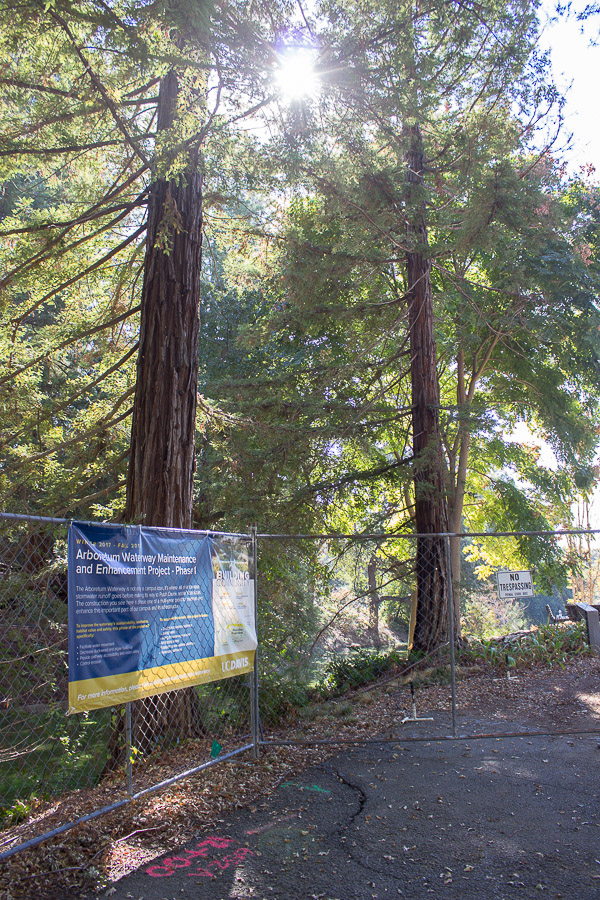 A look at the effort to re-engineer the Arboretum’s waterway
A look at the effort to re-engineer the Arboretum’s waterway
The UC Davis Arboretum’s diversity of trees, plant and animal life has made it a favorite place for community members and students alike to escape. However, the Arboretum’s calmness was partially inconvenienced when its eastern portion, from the Wyatt Deck to its eastern end, was fenced off, drained and dredged last spring. This was the beginning of the first phase in a multi-year Arboretum Waterway Maintenance and Enhancement Project.
Every 20 years, the waterway is dredged to remove sediment deposits, but the current project also includes additional measures intended to keep the many habitats in the Arboretum healthier by re-engineering the water’s flow. For years, algae and duckweed have thrived in the low-oxygen levels of the stagnant waterway, but architectural modifications to the waterway aim to solve this problem.
“By introducing flow into what had been a stagnant system, we are creating new conditions where mats of algae can’t form,” said Andrew Fulks, the assistant director of the UC Davis Arboretum. “[Algae] like stagnant water, so we are removing the stagnation. By drawing from water at Lake Spafford and pumping it to the east end of the waterway, we are pulling water with higher oxygen and keeping it circulating through the system.”
According to the Waterway Project’s website, this new flow will be accomplished by installing pumps and creating water level gradients. Since the campus stormwater system drains into the Arboretum waterway, sediment accumulation is a constant issue, but the increasing flow will simplify waterway management in the future.
“We incorporated some design elements in anticipation of future removal needs […] that would allow us to flush sediment and organics to Lake Spafford,” Fulks said. “I suppose we’ll see if we helped matters in 20 years.”
In the meantime, new water and vegetation management strategies will be developed to ensure that the Arboretum’s habitats remain healthy after this drastic alteration of the channel.
“I think we’ll have to figure out how best to manage flow rates, and how to manage weeds that will grow on the banks,” Fulks said. “Now, we’re going to be growing emergent marsh plants, but that will also mean weeds will come in as well. That’s probably the biggest challenge I foresee.”
As Fulks said, each section of the Arboretum presents its own unique management and construction-access challenges throughout the project.
“On the east end, the paths are close to the water so you can’t let the water get too high,” Fulks said. “In the Redwood Grove you don’t have a lot of sunlight, so you have to find wetland plants that can handle shade. Lake Spafford is more like an urban pond, so the vegetation needs to look more manicured […] Adaptive management is key.”
Even with these known challenges, Fulks and the management team are continually learning how to adapt and better prepare for future phases.
As the sustainability and aesthetics of the Arboretum are improved, the Waterway Project has also opened up new involvement opportunities for students.
“Now, with Nina Suzuki as our waterway steward, we have the Waterway Internship,” Fulks said. “Students learn how to monitor water quality, [do] habitat enhancement plantings along the banks, come up with outreach programs and [work] with faculty on studies.”
The Waterway Stewardship is a three hour per week internship that gives students hands-on water management and habitat restoration experience.
“The Learning by Leading Waterway Stewardship [student] team is learning about urban watershed management and will soon be planting thousands of native sedges and rushes on the banks of the Phase 1 project area,” Suzuki said. “With active management, we can transform the Arboretum Waterway into a campus amenity that complements the beauty and educational value of the plant collections, increases water quality and supports native wildlife and plants.”
Giving students these opportunities to engage in maintaining the Arboretum’s many habitats ensures that the park will remain a vital escape to find inspiration and serenity. Despite the construction going on in the park, students are still able to relax in this part of campus and explore different activities.
“I think that painting in nature can sometimes yield a lot more variety than just buildings or still lifes that we set up,” said Emily Clark-Kramer, a graduate student in the Art Department who took her painting class outside to paint in the Arboretum. “Because you’re painting outside everything is constantly changing. Having to deal with constantly changing shadows and light provides a different type of painting experience that I think is valuable.”
The array of easels perched on the grass above Lake Spafford is emblematic of that unique blend of tranquility and invigoration that nature can stir in people. As the Waterway Project progresses, this generation’s stewardship of the park will allow its beauty to be enjoyed by generations to come.
Written by: Benjamin Porter — features@theaggie.org




